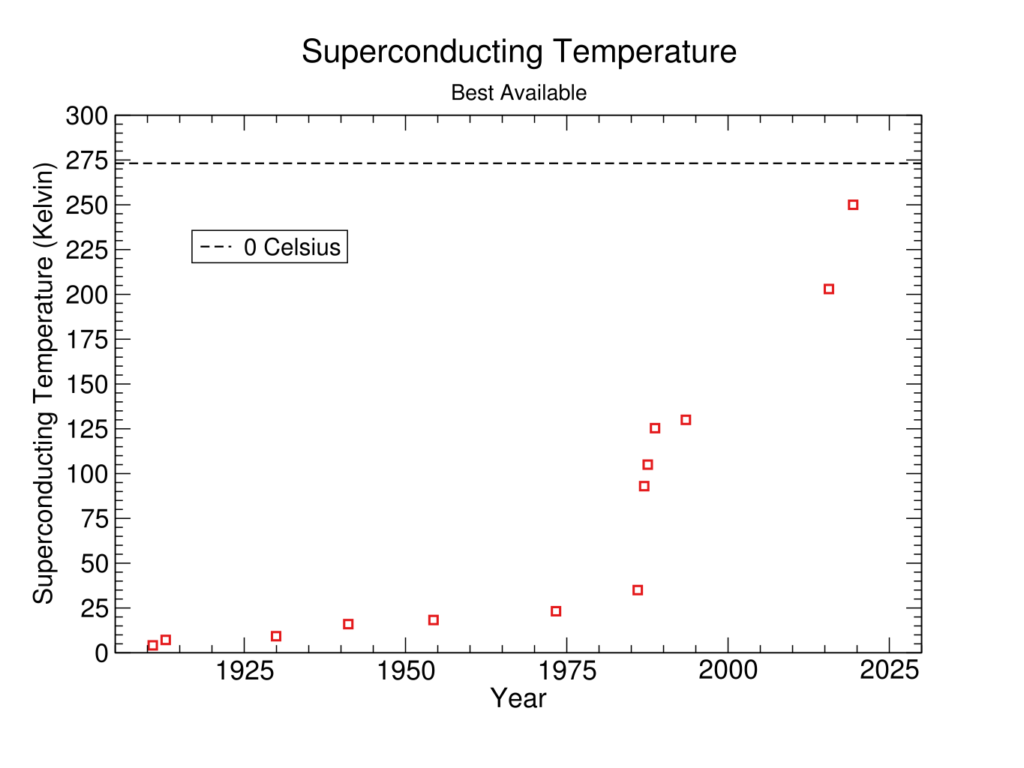Table of Contents
Historic trends in the maximum superconducting temperature
Published 07 February, 2020; last updated 28 May, 2020
The maximum superconducting temperature of any material up to 1993 contained four greater than 10-year discontinuities: A 14-year discontinuity with NbN in 1941, a 26-year discontinuity with LaBaCuO4 in 1986, a 140-year discontinuity with YBa2Cu3O7 in 1987, and a 10-year discontinuity with BiCaSrCu2O9 in 1987.
YBa2Cu3O7 superconductors seem to correspond to a marked change in the rate of progress of maximum superconducting temperature, from a rate of progress of .41 Kelvin per year to a rate of 5.7 Kelvin per year.
Details
This case study is part of AI Impacts’ discontinuous progress investigation.
Background
Superconductors were discovered in 1911.1 Until 1986 the maximum temperature for superconducting behavior had gradually risen from around 4K to less than 30K (see figure 2 below). Theory at the time apparently predicted that 30K was an upper limit.2 In 1986 a new class of ceramics known as YBCO superconductors was discovered to allow superconducting behavior at higher temperatures: above 80K,3 and within seven years, above 130K.4
Trends
Maximum temperature for superconducting behavior
We looked at data for the maximum temperature at which any material is known to have superconducting behavior.
Data
We found the following data in a figure from the University of Cambridge’s online learning materials course, DoITPoMS,6 and have verified most of it against other data sources (see our spreadsheet, where we also collected ‘Extended data’ to verify that these were indeed the record temperatures).
We display the original figure from DoITPoMS in Figure 2 below, followed by our figure, Figure 3, which includes the a more recent superconducting material, H2S.


Discontinuity measurement
We modeled this data as linear within two different regimes, one up to LaBaCu04 in 1986, and another starting with 1986 until our last data point.8 Using previous rates from those trends, we calculated four greater than 10-year discontinuities (rounded), shown in the table below:9
| Year | Temperature | Discontinuity | Material |
| 1941 | 16 K | 14 years | NbN |
| 1986 | 35 K | 26 years | LaBaCuO4 |
| 1987 | 93 K | 140 years | YBa2Cu3O7 |
| 1987 | 105 K | 10 years | BiCaSrCu2O9 |
In addition to the size of this discontinuity in years, we have tabulated a number of other potentially relevant metrics here.10
Changes in the rate of progress
We note that there was a marked change in the rate of progress of maximum superconducting temperature with YBa2Cu3O7. The maximum superconducting temperature changed from a rate of progress of .41 Kelvin per year to a rate of 5.7 Kelvin per year.11
Notes
- “Superconductivity is a phenomenon of exactly zero electrical resistance and expulsion of magnetic flux fields occurring in certain materials, called superconductors, when cooled below a characteristic critical temperature. It was discovered by Dutch physicist Heike Kamerlingh Onnes on April 8, 1911, in Leiden.” – “Superconductivity”. 2018. En.Wikipedia.Org. Accessed June 29 2019. https://en.wikipedia.org/w/index.php?title=Superconductivity&oldid=903681858.
- “Until 1986 it was thought that superconducting behaviour was confined to certain materials at temperatures below ~30 K. A theory called “BCS theory” after its creators John Bardeen, Leon Cooper and Robert Schrieffer had been formulated to describe superconductivity. This theory, for which its creators received the Nobel Prize in Physics in 1972, appeared to back this up but put a limit on the critical temperature of around 30 K.” –I“Doitpoms – TLP Library Superconductivity – Discovery And Properties”. 2019. Doitpoms.Ac.Uk. Accessed June 29 2019. https://www.doitpoms.ac.uk/tlplib/superconductivity/discovery.php.
- “Yttrium barium copper oxide (YBCO) is a family of crystalline chemical compounds, famous for displaying high-temperature superconductivity. It includes the first material ever discovered to become superconducting above the boiling point of liquid nitrogen (77 K) at about 92 K.” – “Yttrium Barium Copper Oxide”. 2019. En.Wikipedia.Org. Accessed June 29 2019. https://en.wikipedia.org/w/index.php?title=Yttrium_barium_copper_oxide&oldid=903757351.
- “Here we provide support for this conjecture, with the discovery of superconductivity above 130 K in a material containing HgBa2Ca2Cu3O1+x (with three CuO2 layers per unit cell), HgBa2CaCu2O6+x (with two CuO2 layers) and an ordered superstructure comprising a defined sequence of the unit cells of these phases”
Schilling, A., M. Cantoni, J. D. Guo, and H. R. Ott. 1993. “Superconductivity Above 130 K In The Hg–Ba–Ca–Cu–O System”. Nature 363 (6424): 56-58. Springer Nature. doi:10.1038/363056a0. - From Wikimedia Commons: Mai-Linh Doan [CC BY-SA 3.0 (http://creativecommons.org/licenses/by-sa/3.0/)]
- See our spreadsheet to see the trends, and our methodology page for details on how we divide the data into trends and how to interpret the spreadsheet.
- See our methodology page for more details.

